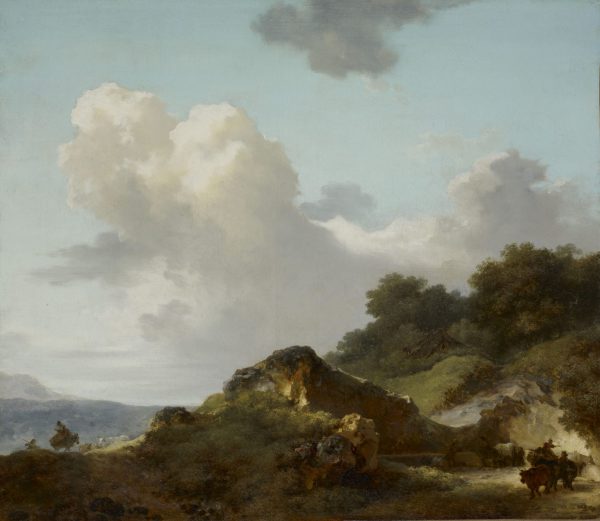The Rock, Ca. 1763-1765.
Oil on canvas, H. 0.53 m; W. 0.62 m
Signed lower left: Fragonard.
Provenance: Hippolyte Walferdin ;
His sale, Paris, April, 12-16,1880, n° 54 ;
Auguste Courtin, his sale, Paris, March, 29, 1886, n° 7 ;
Anonymous sale, March, 4, 1897, n° 16 ;
Anonymous sale, April, 8, 1908, n° 9 ;
G. de Lauverjat ;
Arthur Veil-Picard ;
J. Veil-Picard ;
Private Collection, Paris.
- P. de Saint-Victor, « Exposition de tableaux anciens », Beaux-Arts, 19 octobre 1860, n. p.
- Edmond and Jules de Goncourt, Fragonard, Paris, 1865, p. 338-339.
- Baron R. Portalis, « La collection Walferdin et ses Fragonard », in Gazette des Beaux-Arts, Avril 1880, p. 305 ;
- Roger Portalis, Honoré Fragonard, sa vie, son œuvre, Paris, 1889, p. 126.
- V. Josz, Fragonard, mœurs du XVIIIème siècle, Paris, 1901, p. 161.
- Pierre de Nolhac, J.-H. Fragonard, 1732-1806, Paris, 1906, p. 141.
- Louis Réau, Fragonard, Paris, 1956, p.186.
- Georges Wildenstein, The Paintings of Fragonard, Aylesbury, 1960, no. 127 (fig. 80).
- Daniel Wildenstein and Gabriele Mandel, L’opera completa di Fragonard, Milan, 1972, no. 127, fig. 80.
- Pierre Rosenberg, Tout l’œuvre peint de Fragonard, Paris, 1989, p. 86, no. 129, repr.
Fragonard was a pupil of Jean Siméon Chardin and François Boucher. He obtained the Prix de Rome in 1752 and worked under Carle Vanloo in the Ecole royale des élèves protégés for three years. From 1756 to 1761 he studied at French Academy in Rome, at this time directed by Natoire who encouraged his pupils to work out of doors and draw landscapes. In Rome, Fragonard became a close friend of Hubert Robert and the Abbé de Saint-Non. Fragonard and Robert worked a lot together in the country side and influenced each other profoundly in style. During the summer of 1760 a visit to the villa d’Este at Tivoli was going to have a decisive impact on Fragonard’s artistic career.
On his return to Paris in 1761, Fragonard undertook a series of landscapes close in style to Dutch 17th century painting. The Rock reveals a direct influence of Dutch 17th century landscapes on the aesthetics of that time. Fragonard’s admiration for Jacob van Ruisdael, whose influence is evident in the present picture, was already brought to light. With great subtlety Fragonard shows condensed and sometimes threatening clouds that find an echo with the rough terrain and the silhouettes of trees. Far from a simple imitation, Fragonard reinterprets the style of his predecessors according to his eighteenth century sensibility.
Whether or not Fragonard actually ever travelled to Holland remains uncertain. However, he could easily have studied Dutch 17th century landscapes in private collections in Paris. French collectors in the second half of the 18th century had a great passion for this genre and some of the finest examples could be found in their collections. Pierre-Louis-Paul Randon of Boisset, Receiver General Finance, who briefly owned our painting, had amassed one of the most important collections of 18th century Paris, including over a hundred Dutch paintings.
Another Fragonard painting, entitled The Watering Place, has also been linked with The Rock as its possible pendant. The two paintings were in the Walferdin collection, though sold separately, and were again together in the de Lauverjat and Veil-Picard collections.



